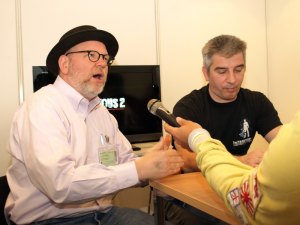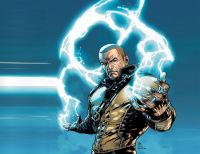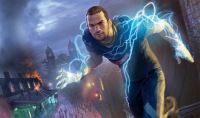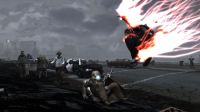NEWS
News | PS3
GAMESCOM — Interview: Bruce Oberg über inFamous 2Bruce Oberg ist Mitbegründer vom Games-Studio Sucker Punch, und Chefentwickler von inFamous 2. An der Gamescom in Köln konnten wir mit ihm über das PS3-Spiel sprechen, welches nächstes Jahr erscheinen soll —Â Angespielt haben wir das Spiel natürlich auch bereits. Das Interview bedeutet gleichzeitig Premiere für Wisegamers tv, unseren neuen YouTube-Channel. Wisegamers: Wie kann Sucker Punch (ein vergleichsweise kleines Studio) Spiele produzieren, die mit Titeln von grossen Developern mithalten können? Bruce Oberg: Bereits zu Beginn von inFamous 1 wussten wir, dass wir ein kleines Team sein wollten. Also trafen wir bereits früh Entscheidungen, dank denen ein kleines Team viele verschiedene Dinge in der Stadt bauen konnte. Wir wollten eine grosse Stadt — Empire City —Â mit einem überschaubaren Team machen, und für inFamous 2 wollten wir das Team nicht vergrössern. Um das zu erreichen verwenden wir verschiedene Tricks. Die Stadt ist aus Sechsecken gebaut; wenn man sie aus der Luft betrachten würde, würde man das beispielsweise in einigen Strassen erkennen. Dadurch können wir die Stadt aus "Lego-Blöcken" aufbauen, wir können viele verschiedene Dinge in die Stadt stellen, ohne jeden Teil der Stadt neu machen zu müssen. Wir können Dinge wiederverwenden, aber es sieht trotzdem nicht so aus als ob man immer die selben Dinge sehen würde. Ein anderer Trick ist wie wir die Fussgänger auf der Strasse machen. Es gibt nur ein Skelett, aber wir können die Leute grösser machen, oder dicker, oder wir können die Gangart verändern. Wir können die Animationen mit kleinen Einstellungen anpassen, so dass wir aus einer kleinen Menge von Animationen viele verschiedene Bewegungen generieren können. So bekomme ich viel Abwechslung aus einem kleinen Team. Was tut Sucker Punch, um trotz kurzen Release-Cycles gute Spiele auf den Markt bringen zu können? Als wir die Sly-Serie auf der PlayStation 2 machten hatten wir drei Jahre für das erste Spiel, aber damals wussten wir sehr wenig über die PlayStation 2. Das zweite Sly dauerte noch zwei Jahre, weil wir die PlayStation 2 ein bisschen besser kannten. Dass dritte Sly-Spiel hat uns nur noch ein Jahr gekostet. Für inFamous läuft es aktuell ähnlich. Wir wissen jetzt etwas über die PlayStation 3; als wir mit inFamous 1 begonnen haben, wussten wir noch nichts über die Konsole, wir mussten alles neu lernen. Aber jetzt wissen wir viel. Wir verwenden quasi die selben Tools wie beim ersten Spiel, und wir haben beinahe das selbe Team das diese Tools bereits kennt. Wir müssen nicht mehr lernen wie die Tools funktionieren. Das ist beinahe wie ein Musikinstrument, zuerst muss man die Akkorde lernen, aber jetzt weiss das Team wie man mit den Tools richtige Musik macht. Es ist alles ein Lernprozess, und wir sind glücklich mit dem Fortschritt, den wir machen konnten. Wie verwendet Sucker Punch Benutzer-Tests, um die Spiele zu verbessern? Sony besitzt spezielle Räume dafür. Das sind Räume mit einem Spiegel an der Wand, und alle Beteiligten sind in dem Raum. Wir nehmen die Spieler mit Videokameras auf. Wir nehmen auf was sie spielen, aber wir filmen auch die Reaktionen der Spieler. So können wir beides später anschauen, und wir haben natürlicha uch Audio-Aufnahmen der Dinge, die die Spieler sagen. Aber im Spiel nehmen wir ebenfalls alles auf. Jedes mal wenn der Spieler hüpft, wenn er jemanden erschiesst, wenn er stirbt. Wir nehmen das alles auf, und dann schauen wir es uns an. Und wir fragen uns, wie lange dauert es um von diesem Punkt zum Ende der Mission zu kommen. Wir wollen, dass die Leute immer etwas weiter kommen in dem Spiel, ein regelmässiger Fortschritt. Wir wollen nicht dass sie dauernd sterben. Also nehmen wir auf wo die Leute sterben, und wenn wir sehen dass alle am selben Ort sterben, dann fragen wir uns ob wir etwas ändern müssen. Vielleicht hat's da einen Typen, der aus einer unfairen Position schiessen kann. Wir nehmen also die Spieler auf und die Dinge, die im Spiel passieren. Und wir befragen die Spieler auch, und fragen sie wie sie das Spiel finden. Wir lassen sie darüber reden. Das nehmen wir ebenfalls auf. All das ist enorm viel Information aus einer einzelnen Session. Wir brauchen teilweise mehrere Wochen um diese Daten zu evaluieren, und wir treffen Entscheidungen aufgrund von diesen Daten. Wir wollen, dass das Spiel für alle Spieler unterhaltsam ist, egal ob der Spieler bereits viel Übung hat oder nicht. Wir wollen, dass alle in dem Spiel Fortschritt machen können, und dass alle Spass haben. Wie kann man in einem Videospiel eine konsistente Geschichte erzählen, aber dem Spieler trotzdem den Eindruck geben, dass seine Aktionen einen Einfluss auf die Story haben, und diese verändern? In inFamous 1 gab es zwei Spielenden, je nach dem ob man "gut" oder "böse" war. Der Spieler hatte also ein wenig Einfluss auf die Story. Aber er hatte sehr viel Einfluss auf die Stadt. Wie Fussgänger und die Stadt aussahen war davon beeinflusst, ob der Spieler gute oder böse Aktionen ausführte. Ich denke also, dass die Aktionen des Spielers nicht nur in der Story reflektiert werden müssen. Die Story ist wichtig, aber man kann auch an anderen Orten Einfluss nehmen: wie die Stadt aussieht, wie die Leute reagieren. Wir denken, dass das auch sehr wichtig ist. In inFamous 2 wird es mehr, grössere Entscheidungen geben, klare Entscheide zwischen Gut und Böse. Und wir werden mehrere Spiel-Enden haben. Wir sind uns noch nicht sicher wie das genau funktionieren wird, aber wir wollen dem Spieler definitiv mehr Einfluss geben. Wir lieben dieses Gefühl wenn man ein Spiel spielt, dass man Einfluss auf das Spiel hat, auf verschiedene Arten. Wir denken, dass das eine wirklich gute Erfahrung ist, und wir sind glücklich damit wie die Leute im ersten Spiel darauf reagiert haben. Die Aktionen des Spielers beeinflussen also, wie das Spiel aussieht? In inFamous 1 hat sich Cole verändert, seine Haut wurde beispielsweise dunkler. Wir werden in inFamous 2 vermutlich etwas ähnliches tun. Wir wissen noch nicht genau, was wir tun werden. Aber ja, wir wollen dass sich Cole, Coles Fähigkeiten, die Einwohner von New Marais und die Stadt selbst visuell verändern, abhängig davon wie der Spieler das Spiel spielt. Werden die speziellen Eigenschaften von Elektrizität einen grösseren Einfluss auf das Spiel haben als im ersten Teil? Im ersten Teil konnte man Wasser am Boden als elektrischen Leiter verwenden, das war ein lustiges kleines Ding wenn man es entdeckt, weil wir haben nicht explizit darauf hingewiesen. Im zweiten Teil hat Cole eine neue Waffe namens "Amp", man sieht es auf seinem Rücken. Damit kann er Elektrizität speichern und kontrollieren. Etwas was wir im zweiten Teil wirklich wollte, war ein besseres Nahkampf-System. Faustkämpfe sollten dem Spieler das Gefühl geben, dass er ein Superheld ist. Ein Teil vom Superheld-Sein ist die Fähigkeit, Gegnern richtig Prügel zu verpassen. Im ersten Teil war das nicht so gut wie wir wollten. Im zweiten Teil hat Cole also dieses "Amp", eine Waffe, die man auf verschiedene Arten verwenden kann. Im ersten Teil gab es eher Distanz-Kämpfe, nun wollen wir auch ein gutes Nahkampf-System einbauen. Das "Amp" kann man dafür verwenden. Es gibt Combos, wir ändern den visuellen Stil, die Zeit kann während den Kämpfen langsamer werden wenn Cole einen Gegner fertig macht, und die Kamera passt sich dem auch an. Wir denken also, dass wir Elektrizität in diesem Teil gut erweitern konnten. Vielen Dank für das Interview! [Auf Deutsch]Â Danke schön! Die originale Englisch-Version des Interviews: Wisegamers: How is Sucker Punch able to create games that compete with titles from bigger developers, despite being a rather small team? Bruce Oberg: You know, we knew that we wanted to be a small team at the beginning of inFamous one. So we made decisions that would let a small team create many different types of things in the city. We knew that we wanted to make a big city, Empire City, with a relatively small team, and for inFamous 2, we wanted to stay pretty much the same size. And so we kind of came up with a lot of tricks. The city is laid out in hexagon shapes. If you looked at it from above, you could see it in some of the roads. And that lets us build the city out of "lego pieces", and put lots of different things in so we don't have to make every single part of the city from scratch. We can reuse things, but it still doesn't look like it's the same thing over and over again. And we're doing that in other ways, too. All the pedestrians on the street: there's a single skeleton, but we have ways to make someone taller, or fatter, or change their walk, change the animations with little dials so that we can make a small set of animations, and change them and tweak them. And there, I get a lot of variation with a small team. How does Sucker Punch manage to keep release cycles short, while still keeping quality high? Well, when we made the Sly series on the PlayStation 2, the first Sly took us three years to finish, but then we knew a little bit about the PlayStation 2. And the second Sly took us two years, and the final Sly only took us a year. So we're kind of coming up on that same time frame for the inFamous series. We know a little bit about the PlayStation 3. When we started inFamous, we didn't know anything, we were learning about the PlayStation 3 from nothing. But now we know a lot about it. We're using basically the same tools to create inFamous 2, and we have mostly the same team of people who all kind of know how the tools work, and so they're not just learning how to use things, they already know how to use it. So it's kind of like an instrument, at first you figure out the chords, and now we feel like the team knows how to play real music using the tools that we've made. So it's all a learning process, and we're really happy with the amount of progress we've been able to make. How does Sucker Punch use user testing to improve its games? We have special rooms that Sony owns. They're great, they're like a room with a mirror on the wall, and we have all the people set up. We videotape the players. We videotape what they're playing, but we also videotape their reactions, so we can watch both of those, and we keep audiotape of what they're saying. But inside the game, we also record everything that happens, every time they shoot, every time they climb, every time they kill somebody, every time they get killed. We record all that data. And then we look at it. We look at it in a timeline. And we say, okay, how long did it take someone to get from this point of a mission to the end of a mission. We want people to make progress at a steady pace, we don't want them to die all the time. If we have a recording of where everyone died, and we see that everyone's dying in one spot, maybe we need to change that spot, maybe there's a bad guy who can shoot at you unfairly. So we collect a lot of data, and we also record everything that happens with the player, and we have them fill out a form, we have them evaluate the game. And we have them talk about it. And we record all of that, and so it's a lot of information just out of one session. We will look at that data for weeks afterwards, to make decisions. Basically, we want everyone to be able to have a good time playing the game, whether you're high-skilled or low-skilled. We want everyone to be able to make progress and have fun. How do you tell a consistent story, while still giving players the impression of having an impact on what happens? In inFamous 1, there was actually two endings, depending on if you ended "good" or "evil". So there's a little bit of variance in the story, but there is a lot of variance in the way the city reacted to you, if you were good or evil. The way the pedestrians, the way the city looked changed based on how whether you were taking good actions or bad actions. So I think a lot of the changes that you can make in the game are not just the story. The story is important, but you can make changes in a lot of other ways of how the city looks, and how the people act, that reflects how you're playing the game. We thought that was really important. And in inFamous 2, we're putting in more, bigger choices that are very clear about what choice is good and what choice is evil, and we know that we'll have multiple endings. How those are all gonna work out, we're still figuring out. But we definitely want choice. We love that feeling when you're playing a game, that how you're playing it is affecting the game itself in multiple ways. We think that's a really great experience, and we're happy that people have reacted well to that. Will the player's actions be reflected in how the game looks? In inFamous 1, Cole changed. He got darker skin. I believe we're going to do something along those lines. I'm not sure exactly how it'll work out. But yes, we want Cole, Cole's powers, the citizens of New Marais, and the city itself to change visually, based on how you're playing the game. Will the specific properties of electricity have a bigger impact on the gameplay than in the first inFamous? In inFamous 1, water on the ground could be used to electrify other people, so that was a fun little thing when you discovered it, because we didn't actually point it out. In inFamous 2, Cole has this new thing called an Amp, you see it on his back. It's his own tool for harnessing electricity and controlling it. And one of the things we really wanted to do in inFamous 2 is to have a much better melee experience, fighting hand to hand should feel like a superhero. That part of beaing a superhero was beating up on guys close in. In inFamous 1, that wasn't as good as we wanted it to be. And so in inFamous 2, he has this Amp, which is a weapon that he can use in lots of different ways for close-up combat. So where inFamous 1 had lots of range, far combat, we want to have a really good close-up combat experience as well. So the Amp can be used for that. There's combos you can use with the Amp, we change the visual style, we actually slow down the clock when you're doing a finishing move on a guy, the camera is changing depending on how you use the weapons. So we're pretty happy with the way we're extending the use of electricity for Cole's powers. Thank you very much, guys! Danke schön!
Du kannst LKM, den Autor dieses Beitrags, über seine Kontakt-Seite erreichen.
Das könnte dich auch interessieren:TESTBERICHTE Die schärfsten Kopfhörer der WeltGran Turismo 7 (PS4)Google Stadia: Ein holistisches Review (Android, PC)Playerunknown's Battlegrounds PUBG (PC, Xbox One)[Updated] Destiny 2 (PS4, PC, Xbox One)Metroid: Samus Returns (3DS)Mario + Rabbids: Kingdom Battle (Switch)Thimbleweed Park (Mac, PC, Xbox One)Nintendo Switch: Das Review (Switch)Horizon — Zero Dawn (PS4) MEINUNGEN Das Problem mit Destiny 2 (PS4, PC, Xbox One)Weshalb wir Forza 7 nicht reviewen (PC, Xbox One)PS4 VR-Games, nach Übelkeitsfaktor bewertet (PS4)Shenmue 3 und unrealistische Kickstarter-Budgets (DC, PS4, PC)Couch-Gaming: Was spielen, wenn Freunde zu Besuch sind? (Mac, PS3, PS4, Wii U, PC, Xbox 360, Xbox One)Ein Plädoyer für Batterien (PS3, PS4, Wii, Wii U, Xbox 360, Xbox One)Super Smash Bros bald auf 3DS, Wii UNintendo bringt 3DS mit zweitem Analog-Stick (3DS, Wii U)Windows-Spiele auf dem Mac mit Steam Streaming (Mac, PC)Neue Studie zu Gewalt und Videogames |























